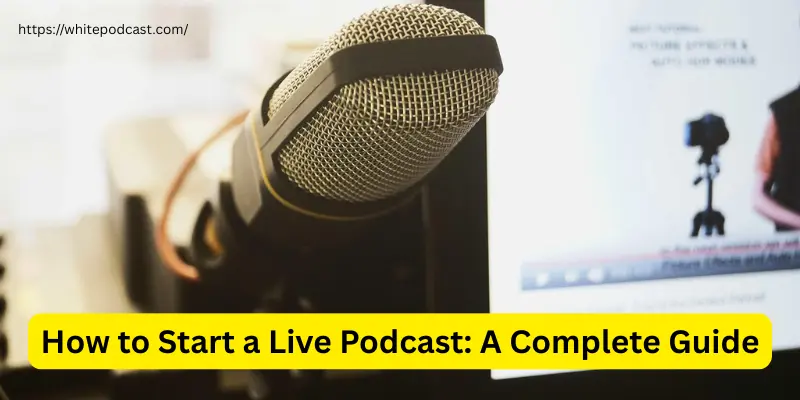How to Start a Live Podcast: A Complete Guide
Published: 2 May 2025
Ready to dive into live podcasting? In this guide, we’ll show you everything you need to know to start recording your podcast live, engage with your audience, and create high-quality content. Let’s get started on making your live podcast a success!
Want to record a live podcast but don’t know where to start? This post will walk you through the essentials—equipment, setup, and tips—so you can create a smooth and engaging live podcast experience. Let’s jump right .

Step 1: Planning Your Podcast Topic
Before hitting the “record” button, it’s essential to plan your live podcast episode. Planning helps you stay on track and deliver valuable content to your audience. Here are the steps to follow:
Choose a Relevant Topic
Pick a topic that resonates with your target audience. Think about what your listeners would find interesting, helpful, or entertaining. Consider current trends, common questions in your niche, or topics that encourage audience interaction. How to Start a Podcast:
Research Your Topic
Even if you’re an expert, doing a bit of research can help you cover your topic more thoroughly. Check out other podcasts, articles, or social media discussions to see what people are saying. This will give you fresh perspectives and ideas to keep your content engaging.
Define the Episode’s Purpose
Every podcast episode should have a clear objective. Is it to inform, entertain, or solve a problem for your listeners? Knowing the purpose of your podcast will help you stay focused and deliver value.
Create a Rough Outline
Even in a live setting, it’s good to have an outline. This helps you stay on topic, avoid rambling, and ensures your podcast flows smoothly. Include an intro, key points to discuss, audience engagement opportunities (like Q&A or polls), and a clear closing. A rough outline will keep things organized without making it sound scripted.
Set a Time Limit
Live podcasts can go on for a while, but it’s important to set a reasonable time limit. Most listeners appreciate a concise, focused episode. Decide on the length of your podcast (e.g., 30 minutes, 1 hour) and stick to it. This will help keep your audience engaged from start to finish.
Step 2: Choosing the Right Equipment
- Microphone: Blue Yeti (USB) or Shure SM7B (XLR)
- Audio Interface: Focusrite Scarlett 2i2 or Behringer UMC22
- Headphones: Audio-Technica ATH-M50x or Sony MDR-7506
- Streaming Software: OBS Studio or StreamYard
- Webcam: Logitech C920 or Canon EOS M50
- Lighting: Ring Light or Softbox Lights
- Internet Connection: 10+ Mbps upload speed
- Camera Stand: Tripod or flexible mount for stable setup
Step 3: Setting Up Your Studio/Environment
A good setup is crucial for a successful live podcast. Here’s how to create an environment that enhances sound quality and overall presentation:
Choose a Quiet Space:
Pick a room with minimal background noise, away from traffic or loud household sounds.
Soundproof the Room:
Use foam panels, carpets, or curtains to reduce echo and external noise. This ensures clear, professional audio.
Optimize Lighting:
Ensure your lighting is even and soft. Avoid harsh shadows or direct light. A ring light or softbox is great for video podcasts.
Keep It Tidy:
A clutter-free background keeps your video visually appealing and professional.
Camera Placement:
Position the camera at eye level for a more engaging and flattering shot.
Comfortable Seating:
Choose a comfortable chair that supports long podcast sessions. Avoid squeaky or noisy chairs.
Cable Management:
Organize cables to avoid tangling and create a clean, safe environment.
Step 4: Choosing Live Streaming Platforms
Selecting the right platform for your live podcast is crucial for engagement and ease of use. YouTube Live is one of the most popular choices, offering a wide reach and excellent video quality. It’s perfect if you want to tap into a large audience and interact with them via live chat. How to Start a Podcast from Your Phone:
For podcasts focused on gaming or interactive content, Twitch provides a great experience with real-time engagement tools like chat and donations. Alternatively, Facebook Live is ideal if you’re looking to reach an existing community and promote your podcast across social media.
If you’re hosting guest interviews, Zoom can be a solid choice for video calls, while StreamYard is a simple, browser-based tool that supports multi-streaming and audience interaction. If you want to expand your reach, Restream lets you stream to multiple platforms at once, increasing your visibility.
Step 5: Engaging with Your Audience
One of the key benefits of live podcasting is the ability to interact with your audience in real-time. Here’s how to keep your listeners engaged during your live recording:
Live Q&A:
Encourage listeners to ask questions in the chat. You can pause during your podcast to answer these questions, creating an interactive experience.
Polls and Surveys:
Use platforms that allow you to create live polls or surveys. This not only engages your audience but also helps guide the direction of your podcast.
Shoutouts and Mentions:
Acknowledge comments from your listeners. Giving shoutouts or reading their messages out loud makes them feel valued and keeps the conversation flowing.
Encourage Comments and Reactions:
Ask your audience to comment or react to certain points you make during the podcast. This creates a two-way dialogue, making it feel more personal.
Interactive Features:
Many live streaming platforms have features like live chat, emoji reactions, and live sharing. Make use of these to keep the energy up and make your podcast more dynamic.
Incorporate Listener Suggestions:
Take feedback or suggestions live from your audience, whether it’s on your topic or how you can improve the show.
Promote Your Live Podcast
To ensure that your live podcast reaches your intended audience, promotion is key. Here are a few ways to promote:
- Use Social Media: Share teasers, countdowns, and behind-the-scenes content to get people excited. Platforms like Instagram, Twitter, Facebook, and LinkedIn can be great for this.
- Email Newsletters: If you have an email list, let your subscribers know when the live podcast will be happening. This could be a great way to reach your most loyal followers.
- Collaborate with Guests: If you’re featuring guests, ask them to promote the event to their audience. This expands your reach and brings in new listeners.
- Engage with Communities: Share your live podcast in relevant online communities (like Facebook groups, Reddit, or forums related to your podcast’s niche) to attract listeners who are genuinely interested in the topic.
- Paid Ads: If you want to go the extra mile, use paid ads (e.g., Facebook ads, Instagram ads, or Google ads) to target a broader audience.
Engage with Your Audience During the Live Podcast
- Live Q&A: Answer questions from the audience in real-time.
- Polls/Feedback: Conduct live polls and ask for feedback.
- Shoutouts: Mention listeners by name and read comments.
- Invite Participation: Let audience members join the discussion.
Record and Repurpose Your Live Podcast
Recording your live podcast ensures that the valuable content isn’t lost and can be used in the future. Always have the recording running so you can revisit the material later for other purposes. After the live event, you can edit the recording to create shorter clips or highlights that are easier to consume.
- Record the live podcast: Capture the entire session for future use.
- Edit the content: Create shorter clips or highlights to share.
- Save key moments: Focus on the most engaging parts for promotion.
Repurpose Content Across Platforms
Once your podcast is recorded and edited, it’s time to share it far and wide. By uploading your episodes to podcast directories and other platforms, you increase the chances of attracting new listeners. You can also repurpose content into blog posts or social media updates to keep your audience engaged.
- Upload to podcast directories: Use platforms like Spotify, Apple Podcasts, and Google Podcasts.
- Repurpose for social media: Share snippets, quotes, or key moments.
- Convert into other content: Create blogs or videos based on the episode.
Analyze Performance and Gather Feedback
After your live podcast, it’s crucial to analyze performance metrics like listener numbers, engagement, and retention. This will give you insights into what resonated with your audience and areas to improve. Use the analytics provided by your podcast platform to track these key metrics.
Engage with your audience by asking for feedback during or after the live show. You can request input through surveys, polls, or by simply inviting comments and suggestions. This helps you understand your audience’s preferences and expectations.
Use the feedback and performance data to refine your future episodes. Implement suggestions, adjust your content or format, and focus on improving areas that might have been less successful.
Conclusion
Starting a live podcast can be a rewarding experience, allowing you to engage directly with your audience while building a loyal community. By planning your content, promoting the show, and utilizing real-time audience interaction, you can create a dynamic and successful live podcast. Don’t forget to analyze the performance and feedback to continuously improve your shows, ensuring growth and consistency in your podcasting journey. With preparation and persistence, your live podcast can become a valuable platform for both you and your listeners.
What is the first step in preparing for a live podcast?
a) Recording the podcast
b) Planning your content
c) Promoting the podcast
d) Engaging with your audience during the show
Why is it important to record your live podcast?
a) To have content to repurpose later
b) To monitor audience behavior
c) To increase engagement during the live event
d) To save money on production
What should you do to promote your live podcast?
a) Record the show and forget about promotion
b) Share it only on one social media platform
c) Use multiple platforms like social media, email newsletters, and paid ads
d) Wait for the audience to promote it
How can you engage with your audience during the live podcast?
a) Ignore comments and focus on the topic
b) Run live Q&A, ask for feedback, and acknowledge comments
c) Limit interactions to just the host
d) Only allow audience members to watch without participation
Why should you analyze your podcast’s performance?
a) To identify what worked and make improvements for future episodes
b) To increase the number of ads
c) To focus on more technical aspects
d) To prepare for next week’s topic
When selecting a platform, consider factors like audience size, ease of use, and the ability to interact with listeners. Popular platforms for live podcasts include Zoom, YouTube Live, Facebook Live, and Twitch. Choose the one that best suits your audience’s preferences and your technical setup.
Engagement is key during a live podcast. To keep your listeners interested, consider incorporating real-time Q&A sessions, live polls, and shoutouts to audience members. Responding to comments, asking for feedback, and bringing in audience members to participate in the conversation can also help boost interaction
- Be Respectful
- Stay Relevant
- Stay Positive
- True Feedback
- Encourage Discussion
- Avoid Spamming
- No Fake News
- Don't Copy-Paste
- No Personal Attacks
- Be Respectful
- Stay Relevant
- Stay Positive
- True Feedback
- Encourage Discussion
- Avoid Spamming
- No Fake News
- Don't Copy-Paste
- No Personal Attacks





